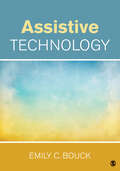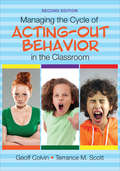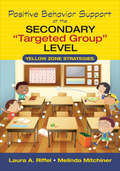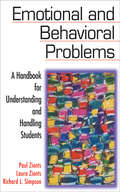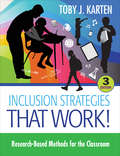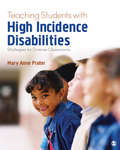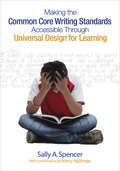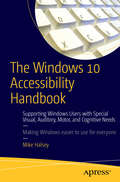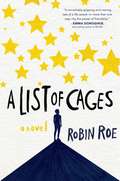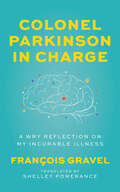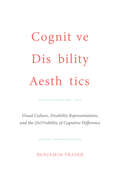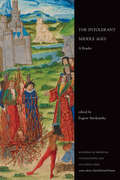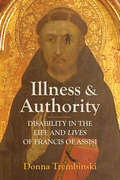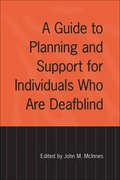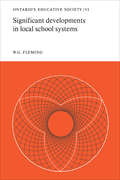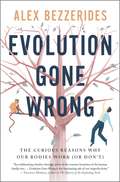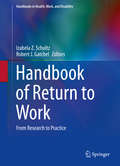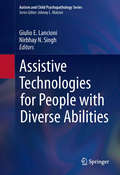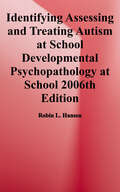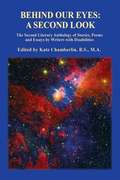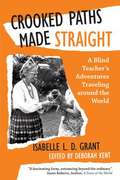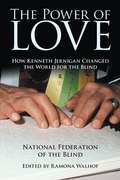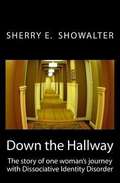- Table View
- List View
Assistive Technology: Gargiulo: Special Education In Contemporary Society 5e + Bouck: Assistive Technology
by Emily C. BouckSuccinct, yet comprehensive, Assistive Technology is designed to help educators better understand assistive technology and how it can support students with disabilities from early childhood through transition into adulthood. This practical book considers the purpose of technology and the support it can provide rather than a student’s disability categorization. Grounded in research and filled with engaging case studies and activities, author Emily C. Bouck offers an unbiased depiction of the advantages and limitations of technology. Readers are exposed to a full range of assistive technology including up-to-date coverage of low- and high-technology, as well as free and for-purchase options that can be used to support students with disabilities.
Managing the Cycle of Acting-Out Behavior in the Classroom
by Terrance M. Scott Geoffrey T. ColvinMinimize problem behavior and maximize student success! Acting-out behavior by students manifests in ways that make classroom management and teaching very challenging. Building on a model using seven phases of acting-out behavior presented in the first edition, the newly updated edition draws on new research in applied behavior analysis, sound instructional principles, and functional behavior assessment to deliver a clear roadmap for educators to design interventions in a clear, systematic, and achievable matter. Features include: Managing each phase of the acting-out cycle—from structuring the classroom, to handling escalated behavior, to recovery Case studies that distill concrete action steps from the book’s concepts Checklists, tools, resources, and templates for applying the book’s principles to any classroom
Positive Behavior Support at the Secondary "Targeted Group" Level: Yellow Zone Strategies
by Laura A. Riffel Melinda S. MitchinerSeal the gaps in student learning with targeted intervention This practical resource addresses the gap between school-wide disciplinary policies and interventions individually tailored to the most problematic students. Focusing on proactive strategies for small-group interventions, Laura Riffel’s research and techniques include: General strategies that can be applied at the individual level: Self-management, proximity control, peer mentoring and more Comprehensive action plans to anticipate any disciplinary issues A behavior rating sheet proven effective in improving student behavior “Funk Sway” For The Classroom: Using Feng Shui principles to create a classroom environment that enhances productivity, learning and creativity
Emotional and Behavioral Problems: A Handbook for Understanding and Handling Students
by Richard L. Simpson Paul Zionts Laura T. ZiontsThe authors take a complex, under-discussed topic and give teachers and administrators useful, basic guidelines they can put to use quickly in understanding, identifying, and helping this special group of students.
Inclusion Strategies That Work!: Research-Based Methods for the Classroom
by Toby J. KartenThe go-to book for including ALL learners in educational success! Teaching students with diverse needs require educators to employ empathy, responsiveness, and patience. This book has long been the indispensable resource for K-12 teachers as they confidently form lesson plans and strategies for inclusion. In this new edition, Toby J. Karten’s data-driven methods are updated with the latest research and policy developments. The book’s content includes: Updated information on ADA, IDEA, writing IEPs, transitional services, classifications, RTI, metacognitive strategies, and links to the Common Core Tips for working with families and making them an integral part of the inclusive team An overview of special education legislative terminology Interactive online forms for planning, documentation, and collaboration
Inclusion Strategies That Work!: Research-Based Methods for the Classroom
by Toby J. KartenThe go-to book for including ALL learners in educational success! Teaching students with diverse needs require educators to employ empathy, responsiveness, and patience. This book has long been the indispensable resource for K-12 teachers as they confidently form lesson plans and strategies for inclusion. In this new edition, Toby J. Karten’s data-driven methods are updated with the latest research and policy developments. The book’s content includes: Updated information on ADA, IDEA, writing IEPs, transitional services, classifications, RTI, metacognitive strategies, and links to the Common Core Tips for working with families and making them an integral part of the inclusive team An overview of special education legislative terminology Interactive online forms for planning, documentation, and collaboration
Teaching Students With High-Incidence Disabilities: Strategies for Diverse Classrooms
by Mary Anne PraterTo ensure that all students receive quality instruction, Teaching Students with High-Incidence Disabilities prepares preservice teachers to teach students with learning disabilities, emotional behavioral disorders, intellectual disabilities, attention deficit hyperactivity, and high functioning autism. It also serves as a reference for those who have already received formal preparation in how to teach special needs students. Focusing on research-based instructional strategies, Mary Anne Prater gives explicit instructions and includes models throughout in the form of scripted lesson plans. The book also has a broad emphasis on diversity, with a section in each chapter devoted to exploring how instructional strategies can be modified to accommodate diverse exceptional students. Real-world classrooms are brought into focus using teacher tips, embedded case studies, and technology spotlights to enhance student learning.
Teaching Students With High-Incidence Disabilities: Strategies for Diverse Classrooms
by Mary Anne PraterTo ensure that all students receive quality instruction, Teaching Students with High-Incidence Disabilities prepares preservice teachers to teach students with learning disabilities, emotional behavioral disorders, intellectual disabilities, attention deficit hyperactivity, and high functioning autism. It also serves as a reference for those who have already received formal preparation in how to teach special needs students. Focusing on research-based instructional strategies, Mary Anne Prater gives explicit instructions and includes models throughout in the form of scripted lesson plans. The book also has a broad emphasis on diversity, with a section in each chapter devoted to exploring how instructional strategies can be modified to accommodate diverse exceptional students. Real-world classrooms are brought into focus using teacher tips, embedded case studies, and technology spotlights to enhance student learning.
Making the Common Core Writing Standards Accessible Through Universal Design for Learning
by Sally A. SpencerUnlock hidden writing skills in all learners through UDL! The Common Core State Standards (CCSS) for writing are promising but are challenging to implement, especially for struggling students. Sally A. Spencer demonstrates the promise of Universal Design for Learning (UDL) as a framework for making the CCSS writing and language standards accessible to all kids. Educators who utilize these strategies will know: How to leverage the strengths of students to optimize writing instruction and overcome their weaknesses The ways UDL can minimize the roadblocks in CCSS implementation How to - and how not to - use technology to teach writing and language conventions
The Windows 10 Accessibility Handbook
by Mike HalseyLearn everything you need to know about making Windows 10 easier to use, see, hear, touch, or read, whether you are using it yourself, setting it up for another person, teaching others about ease of use at work or in the home, or working with a variety of people with specific needs in the community. What you'll learn Manage accessibility in the Settings app, and make use of the Ease of Access Center Make your keyboard and mouse easier to use Make text and windows easier to read Use text or visual alternatives for sounds Use the narrator, and control it using touch and with the keyboard Use Cortana as a smart PC assistant Make use of Windows 10 shortcut keys, and touch and trackpad gestures Use and train the handwriting recognition feature Dictate or navigate using speech recognition Who this book is for The audience for this book includes (but is not limited to) Windows users with special visual, auditory, motor, and cognitive needs, at home and in the workplace. It provides guidance for IT and management professionals who work with such users, as well as the community and statutory groups, organizations, colleges, universities, and government agencies that support them. It is also a guide for friends and family supporting elderly or disabled Windows users in the home, and for anyone else looking for advice on how to make their PC simpler, easier, more productive, and ultimately more enjoyable to use. Table of Contents Chapter 1: Introducing Accessibility in Windows 10 Chapter 2: Identifying Your Needs Chapter 3: Using Windows 10 with a Visual Impairment Chapter 4: Using Windows 10 with a Hearing Impairment Chapter 5: Making the Keyboard and Mouse Easier to Use Chapter 6: Touch and Alternative Input Options Chapter 7: Windows 10 for Memory, Learning, or Other Cognitive Impairments Chapter 8: Managing Accessibility in Windows 10 Mobile Chapter 9: Windows 10 Usability Tips and Tricks
A List of Cages
by Robin Roe<p>When Adam Blake lands the best elective ever in his senior year, serving as an aide to the school psychologist, he thinks he's got it made. Sure, it means a lot of sitting around, which isn't easy for a guy with ADHD, but he can't complain, since he gets to spend the period texting all his friends. Then the doctor asks him to track down the troubled freshman who keeps dodging her, and Adam discovers that the boy is Julian--the foster brother he hasn't seen in five years. <p>Adam is ecstatic to be reunited. At first, Julian seems like the boy he once knew. He's still kind hearted. He still writes stories and loves picture books meant for little kids. But as they spend more time together, Adam realizes that Julian is keeping secrets, like where he hides during the middle of the day, and what's really going on inside his house. Adam is determined to help him, but his involvement could cost both boys their lives. <p>First-time novelist Robin Roe relied on life experience when writing this exquisite, gripping story featuring two lionhearted characters.
Colonel Parkinson in Charge: A Wry Reflection on My Incurable Illness
by François GravelA writer’s witty and surprisingly optimistic account of learning to live with Parkinson’s disease. When he was sixty-five, François Gravel was diagnosed with Parkinson’s disease, upending the old age he had imagined for himself. As a way of contemplating his new life with a degenerative illness, he turned to what he knew best and loved most: writing. Gravel immersed himself in research on Parkinson’s, exploring its medical history and treatments and paying close attention to the changes he experienced, all in service of learning how to best manage his symptoms throughout the advancement of this incurable disease. With a lightness of touch that belies a difficult subject (he imagines Dr. Parkinson as a military man who has set up camp in his brain), Gravel shares what he has learned in a memoir that is at once charming, serious, and moving. He writes, “For a long time, I believed that Parkinson’s was a disease. Now, I realize it’s a philosophy course.” Colonel Parkinson in Charge is, in some ways, the companion text for this course, engaging with and demystifying a daunting subject to help readers better understand life with Parkinson’s disease.
Cognitive Disability Aesthetics: Visual Culture, Disability Representations, and the (In)Visibility of Cognitive Difference (Toronto Iberic)
by Benjamin FraserCognitive Disability Aesthetics explores the invisibility of cognitive disability in theoretical, historical, social, and cultural contexts. Benjamin Fraser’s cutting edge research and analysis signals a second-wave in disability studies that prioritizes cognition. Fraser expands upon previous research into physical disability representations and focuses on those disabilities that tend to be least visible in society (autism, Down syndrome, Alzheimer's disease, schizophrenia). Moving beyond established literary approaches analyzing prose representations of disability, the book explores how iconic and indexical modes of signification operate in visual texts. Taking on cognitive disability representations in a range of visual media (painting, cinema, and graphic novels), Fraser showcases the value of returning to impairment discourse. Cognitive Disability Aesthetics successfully reconfigures disability studies in the humanities and exposes the chasm that exists between Anglophone disability studies and disability studies in the Hispanic world.
The Intolerant Middle Ages: A Reader (Readings in Medieval Civilizations and Cultures)
The Intolerant Middle Ages is a collection of primary sources on the history of persecution. The goal of the book is to highlight instances of persecution and violence, as well as those relatively rare but significant episodes of toleration, toward an intentionally broad spectrum of people who existed at the margins of medieval society: heretics, Jews and Muslims, the poor, the displaced and disabled, women, and those deemed sexually deviant. The volume also presents a more geographically diverse Middle Ages by including sources from Central and Eastern Europe as well as the Mediterranean. Sources are organized in thematic chapters, covering everything from "Heresy and Inquisition" to "Disease and Disability." Each document is preceded by a brief introduction and followed by questions for discussion, making The Intolerant Middle Ages an excellent entrance into the lives and struggles of minorities in the medieval world.
Illness and Authority: Disability in the Life and Lives of Francis of Assisi
by Donna TrembinskiIllness and Authority examines the lived experience and early stories about St. Francis of Assisi through the lens of disability studies. This new approach re-centres Francis’s illnesses and infirmities and highlights how they became barriers to wielding traditional modes of masculine authority within both the Franciscan Order he founded and the church hierarchy. So concerned were members of the Franciscan leadership that the future saint was compelled to seek out medical treatment and spent the last two years of his life in the nearly constant care of doctors. Unlike other studies of Francis’s ailments, Illness and Authority focuses on the impact of his illnesses on his autonomy and secular power, rather than his spiritual authority. From downplaying the comfort Francis received from music to disappearing doctors in the narratives of his life, early biographers worked to minimize the realities of his infirmities. When they could not do so, they turned the saint’s experiences into teachable moments that demonstrated his saintly and steadfast devotion and his trust in God. Illness and Authority explores the struggles that early authors of Francis’s vitae experienced as they tried to make sense of a saint whose life did not fit the traditional rhythms of a founder-saint.
A Guide to Planning and Support for Individuals Who Are Deafblind
by John McinnesIn this ground-breaking collection, leading experts in the field address the problems of parents, intervenors, and professionals who work with people who have been deafblind since birth or from a very early age. Individuals who are congenitally deafblind face the same challenges as those who become deafblind later in life, but they have not had the same opportunity to develop the communications skills and a conceptual base needed to construct an understanding of the world. The contributors address identification of deafblindness, planning and intervention, development, family support, and education.Just as McInnes and Treffry's "Deafblind Infants and Children" helped to change the approach to and the perception of deafblind children, this collection will assist in fostering a new approach to the education of and support for older children, youth and adults who are deafblind. An essential part of this process is to set forth standards for program development, implementation, and evaluation, which this volume aims to accomplish. It will make an essential contribution to the expanding field of services for the deafblind population of all ages, and to the improved understanding of parents, family members, and professionals who support them.
Significant Developments in Local School Systems: Ontario's Educative Society, Volume VI
by W. G. FlemingThis volume deals with innovative developments of many different kinds in the local school systems in the years up to 1970. Information was obtained from a sampling of school boards, including the largest. The major purpose is to show what may be expected from an educational organization that gives local authorities a certain amount of leeway to depart from standard procedures. Innovations in teaching, curricular experimentation, changes in the structure and use of school buildings, and the growth of special services are fully covered.
Evolution Gone Wrong: The Curious Reasons Why Our Bodies Work (Or Don't)
by Alex Bezzerides&“An unforgettable journey through this twisted miracle of evolution we call &‘our body.&’&” —Spike Carlsen, author of A Walk Around the BlockFrom blurry vision to crooked teeth, ACLs that tear at alarming rates and spines that seem to spend a lifetime falling apart, it&’s a curious thing that human beings have beaten the odds as a species.After all, we&’re the only survivors on our branch of the tree of life. The flaws in our makeup raise more than a few questions, and this detailed foray into the many twists and turns of our ancestral past includes no shortage of curiosity and humor to find the answers.Why is it that human mothers have such a life-endangering experience giving birth? Why are there entire medical specialties for teeth and feet? And why is it that human babies can&’t even hold their heads up, but horses are trotting around minutes after they&’re born?In this funny, wide-ranging and often surprising book, biologist Alex Bezzerides tells us just where we inherited our adaptable, achy, brilliant bodies in the process of evolution.
Handbook of Return to Work
by Izabela Z. Schultz Robert J. GatchelThis comprehensive interdisciplinary synthesis focuses on the clinical and occupational intervention processes enabling workers to return to their jobs and sustain employment after injury or serious illness as well as ideas for improving the wide range of outcomes of entry and re-entry into the workplace. Information is accessible along key theoretical, research, and interventive lines, emphasizing a palette of evidence-informed approaches to return to work and stay at work planning and implementation, in the context of disability prevention. Condition-specific chapters detail best return to work and stay at work practices across diverse medical and psychological diagnoses, from musculoskeletal disorders to cancer, from TBI to PTSD. The resulting collection bridges the gap between research evidence and practice and gives readers necessary information from a range of critical perspectives. Among the featured topics: Understanding motivation to return to work: economy of gains and losses. Overcoming barriers to return to work: behavioral and cultural change. Program evaluation in return to work: an integrative framework. Working with stakeholders in return to work processes. Return to work after major limb loss. Improving work outcomes among cancer survivors. Return to work among women with fibromyalgia and chronic fatigue syndrome. The Handbook of Return to Work is an invaluable, unique and comprehensive resource for health, rehabilitation, clinical, counselling and industrial psychologists, rehabilitation specialists, occupational and physical therapists, family and primary care physicians, psychiatrists and physical medicine and rehabilitation as well as occupational medicine specialists, case and disability managers and human resource professionals. Academics and researchers across these fields will also find expert guidance and direction in these pages. It is an essential reading for all return to work and stay at work stakeholders.
Assistive Technologies for People with Diverse Abilities (Autism and Child Psychopathology Series)
by Nirbhay N. Singh Giulio E. LancioniThe familiar image of the disabled tends to emphasize their limitations and reduced quality of life. However, many people with cognitive, motor, and other difficulties also have the capacity to enhance their social interactions, leisure pursuits and daily activities with the aid of assistive technology. Assistive devices from the simple to the sophisticated, have become essential to intervention programs for this population. And not surprisingly the numbers of devices available are growing steadily. Assistive Technologies for People with Diverse Abilities offers expert analysis of pertinent issues coupled with practical discussion of solutions for effective support. Its comprehensive literature review describes current and emerging devices and presents evidence-based guidelines for matching promising technologies to individuals. Program outcomes are assessed, as are their potential impact on the future of the field. In addition, chapters provide detailed descriptions of the personal and social needs of the widest range of individuals with congenital and acquired conditions, including: Acquired brain damage. Communication impairment. Attention and learning difficulties (with special focus on college students). Visual impairment and blindness. Autism spectrum disorders. Behavioral and occupational disorders. Alzheimer's disease. Severe, profound and multiple impairments. The scope and depth of coverage makes Assistive Technologies for People with Diverse Abilities an invaluable resource for researchers, professionals and graduate students in developmental psychology, rehabilitation medicine, educational technology, occupational therapy, speech pathology and clinical psychology.
Identifying, Assessing, and Treating Autism at School (Developmental Psychopathology At School Ser.)
by Robin L. HansenThere is no other recently published book on this topic dedicated to school psychologists and other educational professionals. Focuses on the assessment, identification, and treatment of students in the school context. Unlike competing works, this would be an authored (not edited) volume and will, therefore, be much more focused and specific.- This book will be very practical and applied in its orientation. It will give readers direction that they can immediately follow in their school-based practice.- This book will clearly identifies the roles and responsibilities of educational professionals and school psychologists in identification of students with autism.
Behind Our Eyes, a Second Look: The Second Literary Anthology of Stories, Poems and Essays
by Writers Disabilities Kate Chamberlin"Behind Our Eyes: A Second Look" is the second literary anthology by writers with disabilities. The topics range from ridiculously absurd to tragically abusive, from cats and rabbits to guide dogs and even a guiding miniature horse, from medical fiascos to survival tactics, and through pangs of deprivation to heights of success. The vivid tapestry of life these writers weave with their stories, poems, and essays demonstrates what a diverse group of writers they are; yet this tapestry of creative writings showcases how similar they are to each other and to the world. This Behind Our Eyes organization's anthology takes a second look at the intriguing and insightful pieces of sixty-five writers.
Crooked Paths Made Straight: A Blind Teacher's Adventures Traveling Around The World
by Isabelle L. D. Grant Deborah Kent<P>In 1959, two years before she retired from teaching, Dr. Isabelle Grant set off on a yearlong journey around the world with Oscar, her long white cane, in her hand. She had been totally blind for the past twelve years. <P>In Crooked Paths Made Straight, she shares the story of her journey during which she visited twenty-three countries from Great Britain to Fiji. In Karachi, she traveled the streets by rickshaw and struggled to master the Urdu language. In India, she explored the Taj Mahal, and in Burma she slept in a room where lizards raced up and down the walls. <P>At a time when both women and blind people were generally seen as too helpless for solo travel, Grant fearlessly defied conventions. A dedicated teacher with a lifelong commitment to learning, her mission was to learn all she could about education in the countries she visited, in particular the education provided to blind children. <P>Completed in 1965, Crooked Paths Made Straight recounts Grant's journey, a story of dreams deferred that did not shrivel but sprang to life again and again.
The Power of Love: How Kenneth Jernigan Changed the World for the Blind
by National Federation of the Blind<P>The Power of Love: How Kenneth Jernigan Changed the World for the Blind shares the voices of a collection of individuals whose writings reveal the deep truth that serves as the foundation for the life and work of Kenneth Jernigan. <P>His life and their writings together speak of how Thomas Jefferson's self-evident truths imply that equality extends to embrace blind people just as surely as this country has come to understand equality's inclusion of all people regardless of the color of their skin. <P>Ramona Walhof, editor of The Power of Love and longtime friend of Kenneth Jernigan, draws together the distinctive voices of individuals who knew Kenneth Jernigan and whose lives he touched through his work with the National Federation of the Blind. Each of the reflections begins with a brief biographical sketch that introduces the chapter's author and ties his or her life to Kenneth Jernigan and his work. <P>The book concludes with a chapter, "Blindness: The Federation at Fifty," a retrospective written by Kenneth Jernigan himself in the last decade of his life. The Power of Love: How Kenneth Jernigan Changed the World for the Blind gathers a polyphonic chorus of voices that tell how the power of love, coursing through the life of Kenneth Jernigan, changed the world for the blind and, in so doing, changed the world for everyone.
Down the Hallway: The Story of One Woman's Journey with Dissociative Identity Disorder
by Sherry E. ShowalterDiscover the murky and mysterious world of Charmaine who has Dissociative Identity Disorder (DID). Charmaine and her therapist travel together, down a long hall with many secret doors, within Charmaine's brain. As Charmaine questions her sanity, the journey she embarks upon unearths a living nightmare. Her therapist discovers the many personalities that live within her. Working together, in seemingly endless and unexplored territory; Charmaine discovers clues to those who coexist in her complex brain. Witness Charmaine's fears, angst and desperation. Puzzle together the fragments that describe her day to day experiences, coming face to face with her Alters. As you turn page after page, uncovering mesmorizing, often breathtaking moments in the journey into Charmaine's world. Join Charmaine and her therapist as they journey through this personal hell, to emerge whole. From one riveting moment to the next, you will not be able to put this book down. Fasten your seat belt for one hell of a ride.
